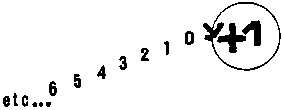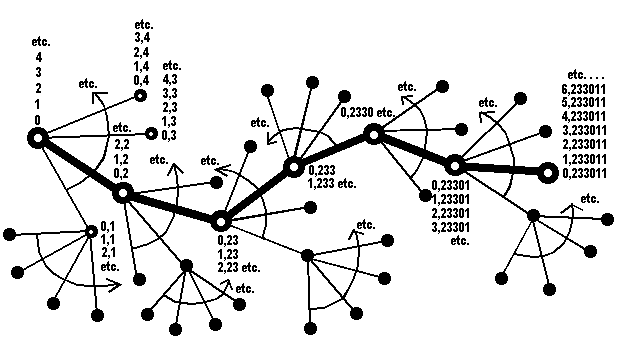home
contents Mathematics
let's go back from zero
Mandelbrot fractal dimensions to the rescue
home |
contents Mathematics |
previous
: let's go back from zero |
next
: Mandelbrot fractal dimensions to the rescue |
| direct to all other pages of the section ----> | 00 | 01 | 02 | 03 | 10 | 11 | 12 | 20 | 21 | 30 | 31 | 32 | 33 | 34 |
How to travel from one number toward another?
We made a point of demonstrating,
that the generation of whole and decimal numbers, has nothing to do with
a path. Whole numbers are generated by the designation of emptiness, and
decimal numbers by several series of graduated deformations.
Nevertheless, you may need to translate
with numbers, the path of particles or things moving in space. Then we
have to find an equivalence between a number and a path, without numbers
losing their properties in the process.
 In
that perspective, we can say that the
path which misrepresents the less the way of generation of whole numbers,
is a circular path. It starts at 0, makes a loop meaning '+ 1', and making
it go back to 0 at the same time.
In
that perspective, we can say that the
path which misrepresents the less the way of generation of whole numbers,
is a circular path. It starts at 0, makes a loop meaning '+ 1', and making
it go back to 0 at the same time.
The departure from 0 and the arrival
at +1 are mixed, and all whole numbers are also mixed in that 0/1.
Producing whole numbers is like
turning on an endless loop, and successively reaching, at its joined point
of departure and of perpetual return, all whole numbers the ones after
the others.
Apparently, the sole loss that whole
numbers suffer from that putting in path, corresponds to the path duration.
We would need to be able to say that the duration of that path is null,
although the time gap between every number to differentiate them is not
null. Which is contradictory.
1/ a first remark must be already done: when we start from 0 toward 1, 2, etc., we don't move away from 0. That is to say we don't approach a point which is infinitely away from 0. We stand at about the same place. The only connection it has with infinity, is that we can indefinitely stand about there, but without ever moving a step forward.
2/
a second remark must be done: when standing about, you cannot hope to meet
at whatever moment, a number looking closely or from far away like a fractional
or like an irrational number. For the loop which goes from 0 to 0, cannot
be allowed to stop between 0 and 0. We saw that when naming empty set we
named at the same time 0, 1, 2, 3, etc., but doing that we were not able
to name whatever could be a possible medium between 0, 1, 2, 3, etc. Thus,
the path which represents this creation process of whole numbers, cannot
stop anywhere in its loop between 2 whole numbers. If it does, it will
denature the process it is aiming to liken.
So, moving from one decimal number
toward another, will have nothing to do with moving from one whole number
toward another. We shall have to draw another type of path.
If we want absolutely to begin the
path toward decimals, by starting from their whole number, then we must
notice that all the paths toward decimals have to begin at the same point
0. For all whole numbers are there.
Now, if we want to draw
a trajectory from 0, which keeps all the data contained in a decimal number,
we can do it by drawing a hierarchical network of junction knots like this:

arborescent pavement
of a plan, with travels of decimal number
[for
the English use of this drawing, read . instead
of
,]
At every crossroads we start 10 paths,
and at the end of each of these 10 paths we draw a new crossroads breaking
up in 10 paths, etc. So, every decimal digit corresponds at the same time,
to a rank in the series of the crossroads we met from 0 (1st, 2nd, 3rd,
etc.), and to the deformation intensity corresponding to one of the 10
possible paths. We can state, for instance, that if we go from 0 toward
decimal infinity, the right path at every crossroads will correspond to
a null deformation, the left path to a deformation 9, and every intermediate
path to a medium deformation between 0 and 9.
Then, we can name a
decimal number using an arrival crossroads, which will be the last where
the deformation will not be null.
Since the paths structure is arborescent, there is only one path going
from 0/1 toward this crossroads.
So, the designation of this crossroads
will be enough to designate all the successive junctions leading to it,
their order, and their intensity. That is to say, enough to designate all
decimal values of the number.
This circulation diagram reproduces the possibility of generating paths which will reach all the decimal numbers, with respect to the characteristics that differentiate the ones from the others. Looking at it, we can make several observations:
1/ first, we find at every crossroads the accumulation of infinity of numbers, all those which are generated in the same way behind the decimal point, but starting every time behind a different whole number. Then, we find again the property of standing about at the same place, which is that of the path linking whole numbers the ones to the others. We go from 1.2102 to 2.2102 for instance, by reproducing at the 1.2102 crossroads, the circular and endless loop we make from 1 to 2.
2/ secondly, we observe that we cannot use a decimal crossroads to designate a full number, with its whole part and its decimal part. That's the converse of what we saw with the whole numbers' path: we found no decimal in it. On the decimals' path, we find this time, no whole number.
3/
finally, contrary to the whole numbers path, we do find a way to travel
till infinity with the decimals. We can take any path from a whole number,
indefinitely sinking deep into decimal numbers' 'infinite depth'. Every
really infinite travel goes toward an irrational number, or a fractional
number whose decimal digits alternate with periodicity which goes on indefinitely.
Now, if we want to measure our displacements
when we follow decimal numbers, and if we want to compare this measure
to the displacements we make when following whole numbers, we have to conclude
that when moving toward infinity, that is to say toward the end of decimal
paths, we don't move of a single thumb toward whole numbers.
In other terms, 3.899 for example,
cannot possibly be considered nearer to 4 than 3.2 is. On the opposite,
if we speak only in terms of distance to travel, we go faster from 3.2
to 4 (one sole stage on the decimal path) than when we go from 3.899 to
4 (3 stages). This abnormality also exists between decimal numbers. In
terms of distance, 3.2 is nearer to 3.9 than to 3.21111111117.
But, do we have to make this sort
of observations, and start calculating, with data such as 3.2 being nearer
to 4 than 3.999 is?
That would be falling back into
the same absurd situation where Cantor led us with infinities.
The only reasonable thing we can
do, is to acknowledge what is now clear, that is:
1/
whole numbers are in a dimension which is incommensurable with the one
of decimal numbers,
2/
and inside decimal numbers, the rank in the decimal queue, is a measurement
which is incommensurable with the value of the digit concerned with that
rank.
That's a situation which is not a
new one in mathematics. The number 'square root of -1' for instance, is
neither positive (its square would be +1), nor negative (its square would
also be +1). Mathematicians learned how to deal with this sort of numbers
that we cannot line up on the same line as positive and negative real numbers.
They have called them: 'imaginary numbers'.
| From now on, what we also have to
acknowledge, is that decimal numbers cannot line up on the same line as
real numbers. That they have with whole numbers the same sort of relation,
that exists between the so call imaginary numbers, and the real numbers.
In this last case, it is said that they are in 'different dimensions'. And that setting a relation between them does not amount to line them up on a straight line, but to let them make a plane together, named 'complex plane'. Now, in an 'even more complex way', we have to say that all the combinations between a whole number and its decimal digits, deal with defining the coordinates of a point in a 'complex volume'. First, we have to define decimal values in the decimal numbers plane. Then, when the right crossroads is found 'in depth and in length', we have to give the 'altitude' which corresponds to the whole number we want to associate with that decimal. In short, when multiplying 2 with 0.2 for instance, we must be ready to be even more careful than when trying to calculate the multiplication of 2 with 'square root of -1'. |
In fact, real numbers are considered nowadays, as part of complex numbers.
The only thing that differentiates them from other complex numbers, is
that they are particularly convenient.
In the same way we now see that decimal numbers with 10 base are only
part of all the decimal numbers. A part particularly convenient for we
can shamelessly add decimals of several numbers as if they were whole numbers,
and for we can multiply a fractional number with a multiple of 10 to shift
shamelessly a decimal digit into a whole number.
Unfortunately,
nature is not aware of this simplicity, and lets develop
its phenomena in such a way that, if we want to express them in a mathematical
language, we have to use decimal numbers in their more complex aspects.
Next, that is what we will try to do.
home |
Math |
top |
next
: |
author |